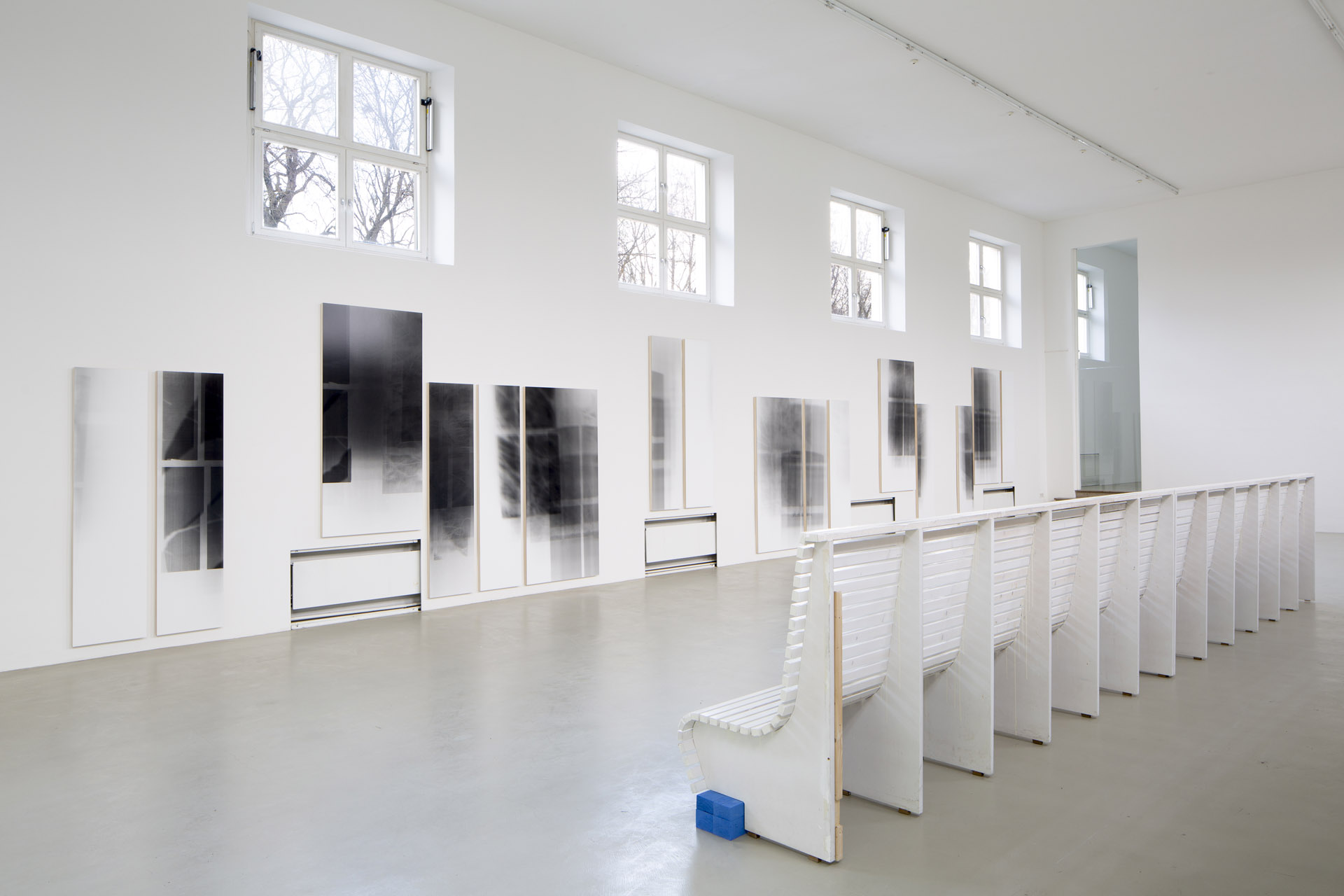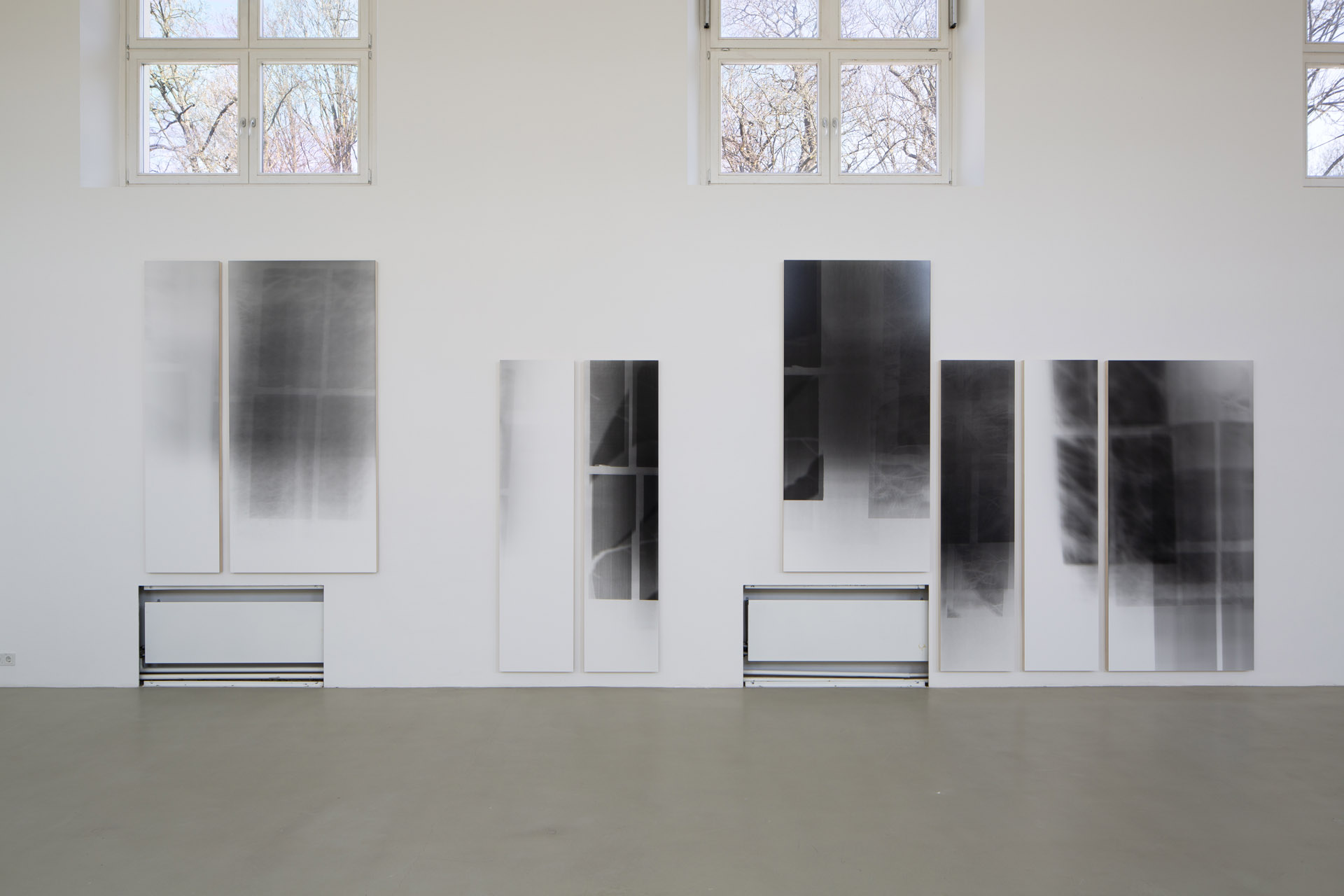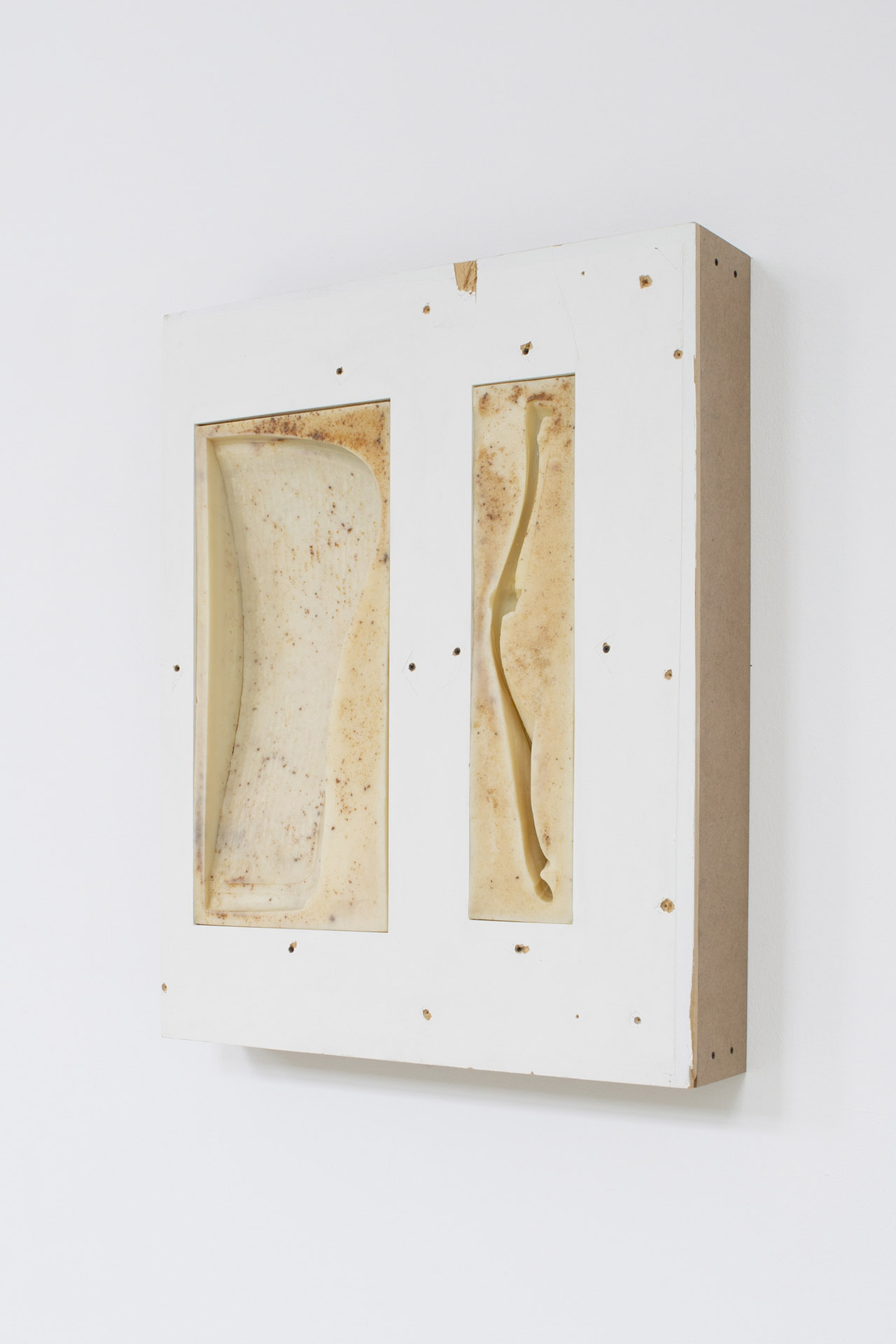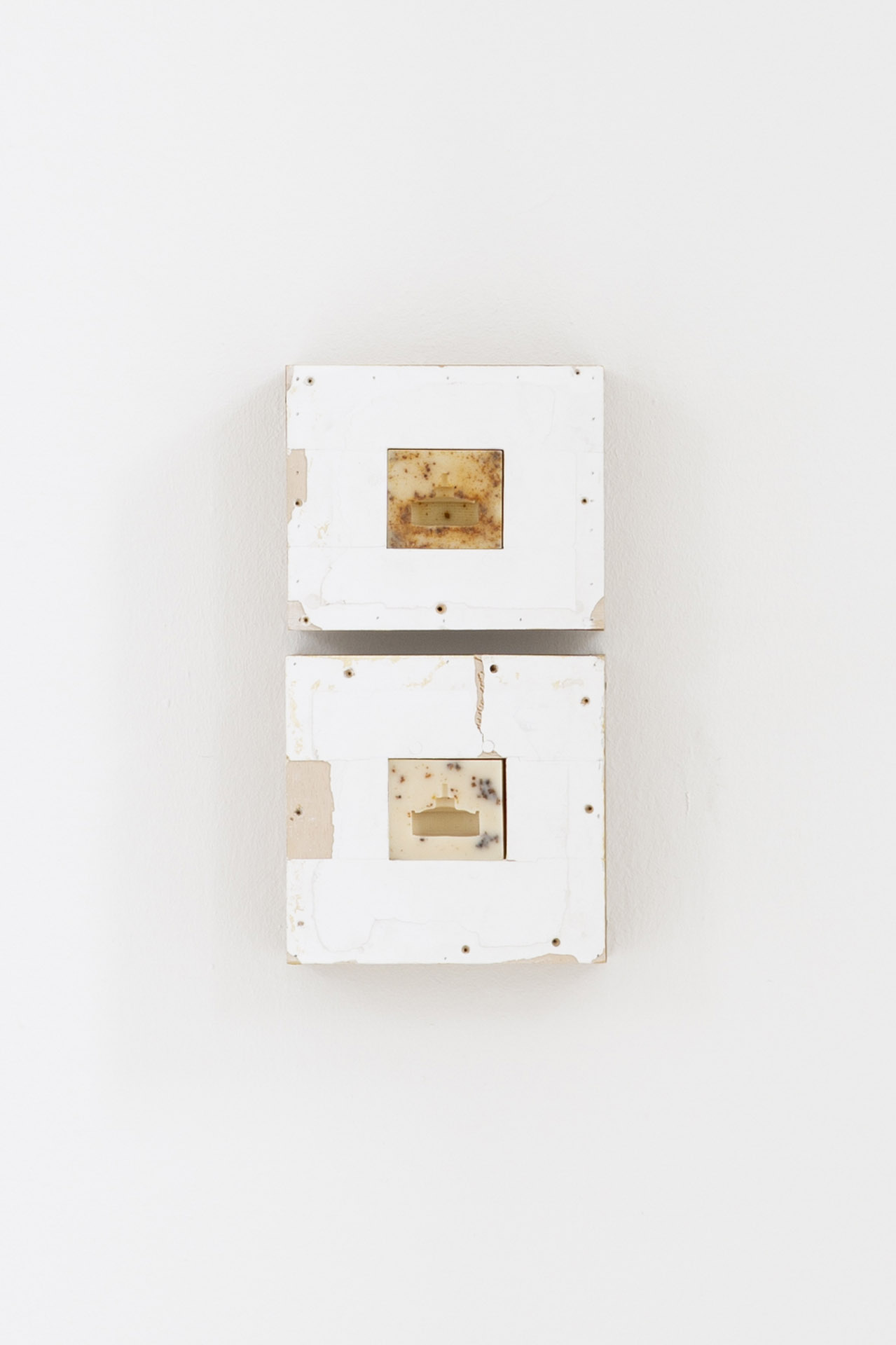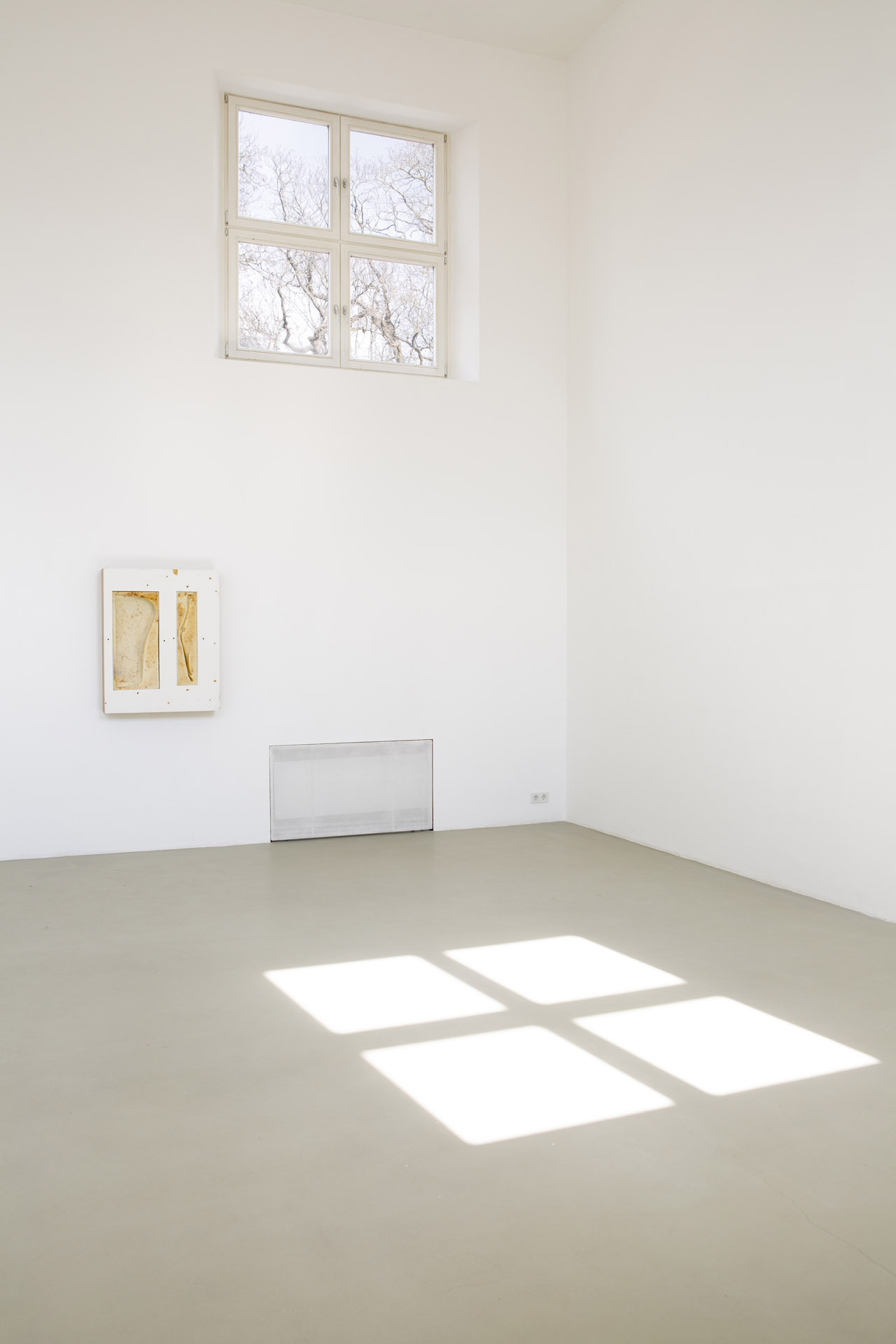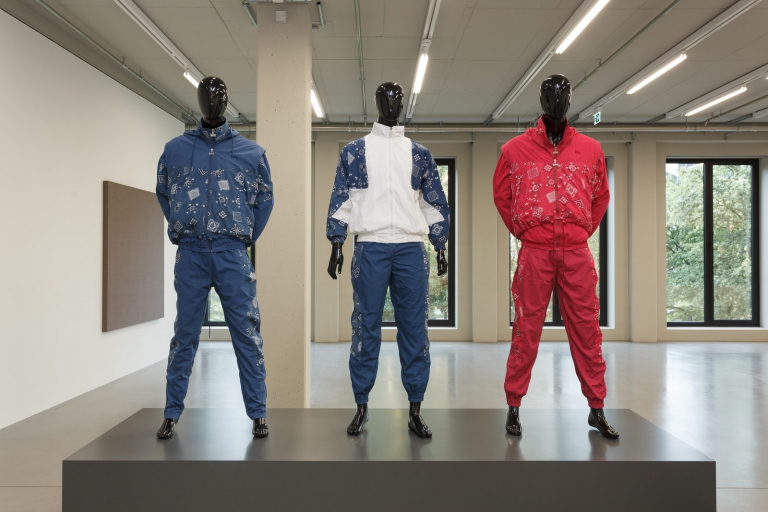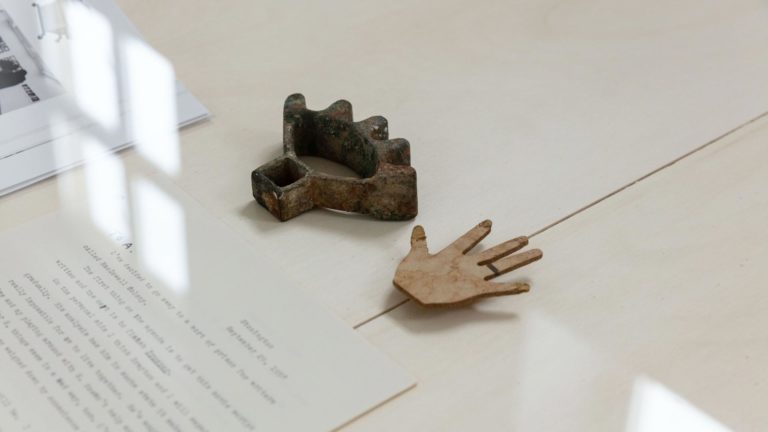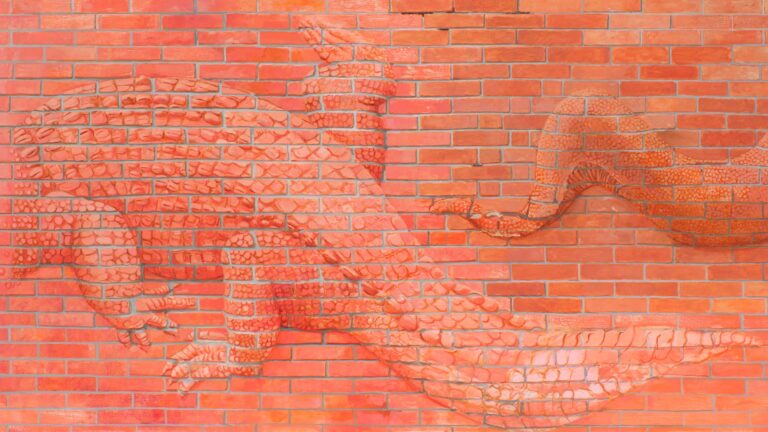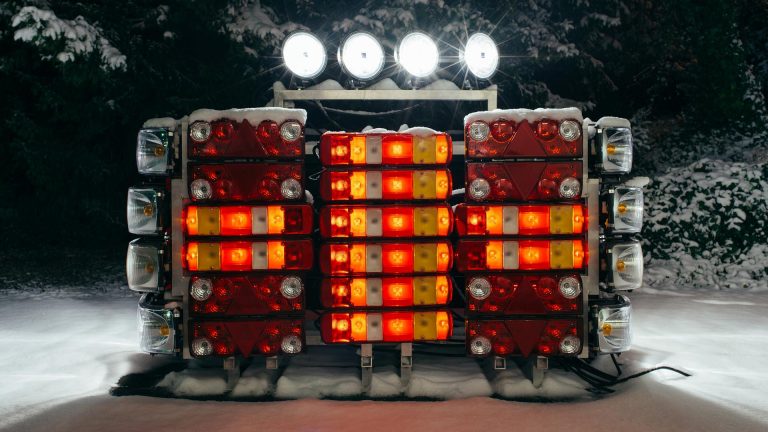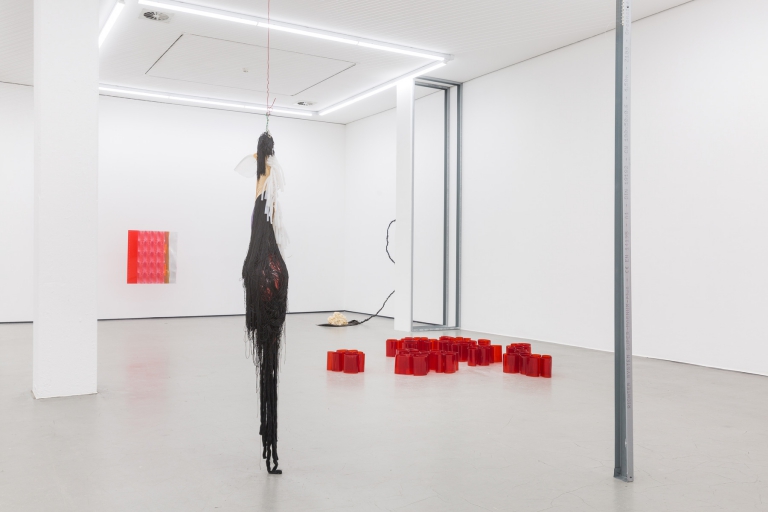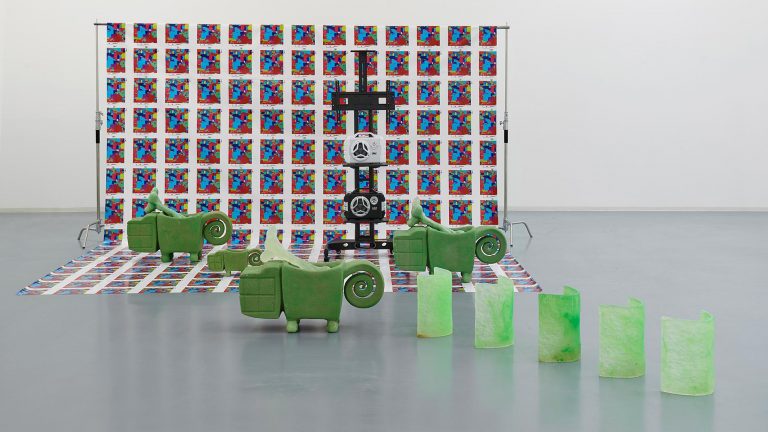Artist: Patricia L. Boyd
Exhibition title: Hold
Curated by: Gloria Hasnay
Venue: Kunstverein München, Munich, Germany
Date: March 9 – June 13, 2021
Photography: All images copyright and courtesy of the artist and © Kunstverein München
Patricia L. Boyd (b. 1980 in London), whose practice encompasses sculpture, photography, writing, and video, develops her artworks through inquiries into the infrastructures and dynamics of their production and presentation. The works on view in Hold at Kunstverein München, many of which intervene into the architecture of the gallery, consider the reciprocal relationship between artistic practices and mechanisms of display. In its figuration of various types of containers and thresholds, Hold further points to the contradictions that structure psychological and institutional spaces.
In the series Wall Pieces (since 2017), Boyd produces negative casts using a homemade mixture that includes recycled cooking grease collected from restaurants. The objects cast include components of an office chair and turntable purchased by the artist at a liquidation auction. When first exhibited, each sculpture is embedded into the wall of the gallery it is shown in. After the initial exhibition, the work is extracted along with the surrounding section of wall in which it was enclosed, which thereafter remains permanently attached to the cast. This “wall piece” is described by the artist as a prosthesis, as it functions to hold the cast in place and to extend it in size and meaning. The process of augmentation is reflected in the work’s title, which is readjusted to include the exhibition’s dates and location. These sculptures point to an interdependence between artist and institution, while mapping exhibition spaces and their palimpsestic uses. Here, it becomes apparent that revisiting and reusing settings and contexts of previous works is a strategy often utilized by the artist, pointing to the recursive temporality that undergirds her approach.
The wall is a defining architectural and metaphorical element within Boyd’s practice. The writer Sara Ahmed states that “[w]alls allow us to think about how obstacles can be physical […] and yet how these obstacles are only obstacles for some bodies.”[1] For Ahmed walls expose the all too common discrepancy between institutional commitments to diversity work and actual lived experiences. Boyd works with walls as surfaces for display and support, and as actual barriers that determine how a space is moved through. Furthermore, for Boyd the wall also represents something less easy to grasp, namely the dynamics that are operative within all kinds of institutions (not just art institutions), through which they protect and advance their agendas, even in unconscious ways.
The placing of the casts is determined by the position of cavity walls within the galleries they are shown in and derives from the basic question of what the “container” is made of or has been before. In many cases, the buildings that art institutions are housed in previously had different (architectural, social, and representational) functions and were remodeled in order to become spaces for the display of art. The Kunstverein’s building initially served as an insulated passageway between courtly venues before it housed first the Museum für Abgüsse Klassischer Bildwerke (Museum of Casts of Classical Sculpture) and later, once rebuilt after World War II, the Kunstverein. Here, there are no cavity walls. Transformations have been made to the space in order to accommodate the casts: an opening above the first doorway has been covered, and an access between two galleries narrowed. Boyd’s Wall Pieces intrude into the pre-existing architectural conditions, extending beyond the limits of—yet nonetheless acknowledging their relationship to—a specific spatial framework. Whereas previous iterations of this body of work have cut into existing walls, at the Kunstverein voids have been filled and the artworks embedded.
Another architectural element in Boyd’s work is the window. In her series Impressions (since 2015), the artist produces photograms of windows and glass surfaces. New works from this series take center stage in the Kunstverein’s main hall, depicting inverted representations of Boyd’s New York apartment windows, and enfolding artistic production into a domestic architecture.
Photograms are an elementary form of photography that capture light falling on a sheet of photographic paper, and as such they are indexical records of specific moments in time. Housed in a building adjacent to the Hofgarten, the Kunstverein’s exhibition spaces, with their high and wide walls uninterrupted by windows at eye level, echo eighteenth-century picture galleries. Visual traces of the outside environment enter the gallery: as the hours of the day go by, sunlight shines through the gallery windows crossing the floor and wall, overlapping with and moving between Boyd’s negative light impressions.
In the newly produced photograms, ambient light from different sources outside the artist’s apartment have been received by the photographic paper during its flash of exposure. Their installation at Kunstverein München, which manifests a further moment of exposure—that of an artwork to an audience—elides domestic and institutional space. In projecting an outside encounter on the flat, unforthcoming surface of the gallery wall, the works address some of the tensions between interiority and exteriority, privacy and publicity, and opacity and transparency that are negotiated through artistic production and display. They further turn the production site itself into a producing device.
Previous photograms from the Impressions series were developed in public spaces, including against the glass panes of bus shelters (Melbourne, 2019) and urban storefronts (San Francisco, 2015; London, 2017). Boyd is drawn to glass as a threshold where public and private interests meet. Logics of control and surveillance are often implicated in glass surfaces. Produced at night through the contingent incidence of light, these works depict the ghostly signs of scratches, inscriptions, or graffiti at their respective locations.
In the Impressions installed at the Kunstverein, the attention to domesticity also acts in kinship with feminist inquiries into the labor and social role of women and the relationship between art making and daily life with respect to gender. In Boyd’s practice, social reproduction is shown to be contingent upon feminist traditions of care. Her video Sweepings (2019), through looping footage of personal to-do lists, documents the maintenance of the gendered self over time.
Boyd’s layered gestures of spatial transformation effect a change in the perception of the Kunstverein’s building, and our own movement therein. This culminates in a final intervention: large panes of glass, perforated with a circular pattern of holes, are inserted into each of the two doorways leading to the institution’s third gallery, invoking an incubator or vitrine yet at the same time imposing a barrier. Visitors are prevented from entering the sealed off room, both accenting and frustrating their role as a spectator.
As permeable marks, the holes in the glass allow for the passage of air and sound.
Behind the glass, the video Chop (2021) depicts a young boy, his head cut off by the edge of the frame, speaking about humans interfering with the natural world and the removal of body parts from endangered animals. Each time he mentions something that has been ‘chopped off’ he makes a cutting gesture with his hands. A second video, Cutting Furrows and Turning Over (2021), references other kinds of cuts and incursions, both in the visual material and the configuration of the edit. It is made from footage of photographs being moved and manipulated on a computer screen, the moiré pattern of the filmed screen adding a further layer of visual mediation. The photographs are of ploughs and their component parts that the artist has accessed through the online database of a collection of historic farming equipment held by The Museum of English Rural Life. In the work, blades cut into the edge of the video frame, oscillating between an abstract composition and ‘real’ diegetic space. Here, the manual action of moving the cursor across a computer screen is also juxtaposed with the idea of manual labor represented by the ploughs.
The function of a plough is to slice into the earth in order to aerate it and bring deeper level nutrients closer to the surface; this allows for depleted, overused soil to be replenished. In tandem with other technological advances in the Industrial Revolution, ploughs became more efficient, meaning that more value could be extracted from the land and at greater speed. The two video works, which together with the glass panes form Incubator (2021), generate a complex interplay of valences and associations in the pastoral vein around labor, productivity, fertility, and the “durational practice”[2] of maintenance—but all at a distance, accessed through an archive and witnessed through a glass interface.
[1] Sara Ahmed, Living a Feminist Life (Durham: Duke University Press, 2017), 135–160, here 135.
[2] After Lisa Baraitser, “Touching Time: Maintenance, Endurance, Care,” in: Stephen Frosh (ed.), Psychosocial Imaginaries (London: Palgrave, 2015).
Installation view: Patricia L. Boyd, Minutes, hours, or days (I, II, III, IV, V, VI, VII), 2021; Untitled, 2021; in: Hold, Kunstverein München, 2021. Courtesy the artist; photo: Constanza Meléndez.
Installation view: Patricia L. Boyd, Minutes, hours, or days (III, IV, V), 2021; in: Hold, Kunstverein München, 2021. Courtesy the artist; photo: Constanza Meléndez.
Installation view: Patricia L. Boyd, Minutes, hours, or days (III), 2021. Courtesy the artist; photo: Constanza Meléndez
Installation view: Patricia L. Boyd, Minutes, hours, or days (VI), 2021. Courtesy the artist; photo: Constanza Meléndez
Installation view: Patricia L. Boyd, Minutes, hours, or days (V), 2021. Courtesy the artist; photo: Constanza Meléndez
Installation view: Patricia L. Boyd, Minutes, hours, or days (V, VI, VII), 2021; in: Hold, Kunstverein München, 2021. Courtesy the artist; photo: Constanza Meléndez
Installation view: Patricia L. Boyd, Minutes, hours, or days (VII), 2021; in: Hold, Kunstverein München, 2021. Courtesy the artist; photo: Constanza Meléndez
Exhibition view: Patricia L. Boyd, Hold, Kunstverein München, 2021. Courtesy the artist; photo: Constanza Meléndez
Installation view: Patricia L. Boyd, Minutes, hours, or days (III, IV), 2021. Courtesy the artist; photo: Constanza Meléndez
Installation view: Patricia L. Boyd, Incubator, 2021 (detail); in: Hold, Kunstverein München, 2021. Courtesy the artist; photo: Constanza Meléndez
Installation view: Patricia L. Boyd, Chop, 2021; Cutting Furrows and Turning Over, 2021; in: Hold, Kunstverein München, 2021. Courtesy the artist; photo: Constanza Meléndez
Installation view: Patricia L. Boyd, Cutting Furrows and Turning Over, 2021; in: Hold, Kunstverein München, 2021. Courtesy the artist; photo: Constanza Meléndez
Installation view: Patricia L. Boyd, Incubator, 2021 (detail); in: Hold, Kunstverein München, 2021. Courtesy the artist; photo: Constanza Meléndez
Video still: Patricia L. Boyd, Cutting Furrows and Turning Over, 2021; in: Hold, Kunstverein München, 2021. Courtesy the artist; photo: Constanza Meléndez
Video still: Patricia L. Boyd, Cutting Furrows and Turning Over, 2021; in: Hold, Kunstverein München, 2021. Courtesy the artist; photo: Constanza Meléndez
Installation view: Patricia L. Boyd, Minutes, hours, or days (III, IV, V), 2021; Untitled, 2021 (detail); in: Hold, Kunstverein München, 2021. Courtesy the artist; photo: Constanza Meléndez
Installation view: Patricia L. Boyd, Untitled, 2021; in: Hold, Kunstverein München, 2021. Courtesy the artist; photo: Constanza Meléndez
Installation view: Patricia L. Boyd, Sweepings, 2019; SL-1200MK2 Insulator Feet (Secession, 06/29/18-09/02/18), 2018; in: Hold, Kunstverein München, 2021. Courtesy the artist; photo: Constanza Meléndez
Exhibition view: Patricia L. Boyd, Hold, Kunstverein München, 2021. Courtesy the artist; photo: Constanza Meléndez
Exhibition view: Patricia L. Boyd, Hold, Kunstverein München, 2021. Courtesy the artist; photo: Constanza Meléndez
Exhibition view: Patricia L. Boyd, Hold, Kunstverein München, 2021. Courtesy the artist; photo: Constanza Meléndez
Exhibition view: Patricia L. Boyd, Hold, Kunstverein München, 2021. Courtesy the artist; photo: Constanza Meléndez
Installation view: Patricia L. Boyd, SL-1200MK2 Insulator Feet (Secession, 06/29/18-09/02/18), 2018; in: Hold, Kunstverein München, 2021. Courtesy the artist; photo: Constanza Meléndez
Installation view: Patricia L. Boyd, Aeron Armrest I-XII (Cell Project Space, 02/01/2019-03/17/2019), 2019; in: Hold, Kunstverein München, 2021. Courtesy the artist; photo: Constanza Meléndez
Installation view: Patricia L. Boyd, Absorption, Elimination II: Aeron Back Support (CCA Wattis, 10/12/17-02/24/18), 2017; in: Hold, Kunstverein München, 2021. Courtesy the artist; photo: Constanza Meléndez
Installation view: Patricia L. Boyd, SL-1200MK2 Insulator Feet (Secession, 06/29/18-09/02/18), 2018; in: Hold, Kunstverein München, 2021. Courtesy the artist; photo: Constanza Meléndez
Installation view: Patricia L. Boyd, Absorption, Elimination II: Aeron Back Support (CCA Wattis, 10/12/17-02/24/18), 2017; in: Hold, Kunstverein München, 2021. Courtesy the artist; photo: Constanza Meléndez
Installation view: Patricia L. Boyd, Absorption, Elimination II: Aeron Back Support (CCA Wattis, 10/12/17-02/24/18), 2017; Underwork, 2021 (detail); Masterwork, 2021 (detail); in: Hold, Kunstverein München, 2021. Courtesy the artist; photo: Constanza Meléndez
Exhibition view: Patricia L. Boyd, Hold, Kunstverein München, 2021. Courtesy the artist; photo: Constanza Meléndez
Installation view: Patricia L. Boyd, Lumbar Formation IX (Christian Andersen, 09/25/2019-12/21/2019), 2021; in: Hold, Kunstverein München, 2021. Courtesy the artist; photo: Constanza Meléndez
Installation view: Patricia L. Boyd, Underwork, 2021; Untitled, 2021; in: Hold, Kunstverein München, 2021. Courtesy the artist; photo: Constanza Meléndez
Installation view: Patricia L. Boyd, Me, Not, Not-me (I, II), 2020; in: Hold, Kunstverein München, 2021. Courtesy the artist; photo: Constanza Meléndez
Installation view: Patricia L. Boyd, Untitled, 2021; in: Hold, Kunstverein München, 2021. Courtesy the artist; photo: Constanza Meléndez


